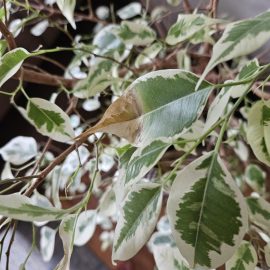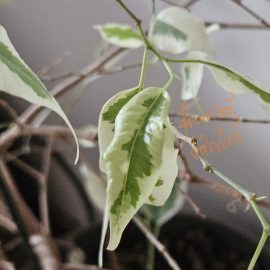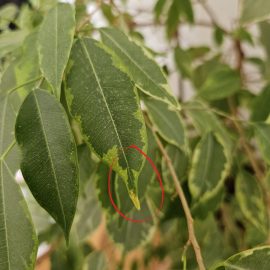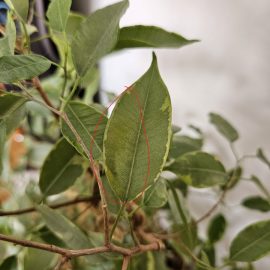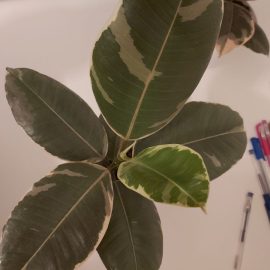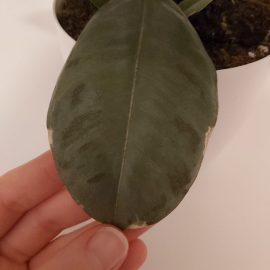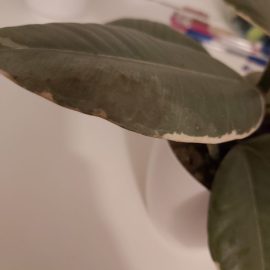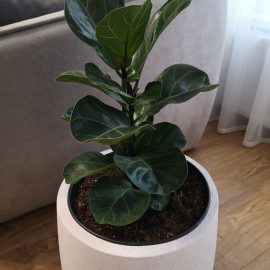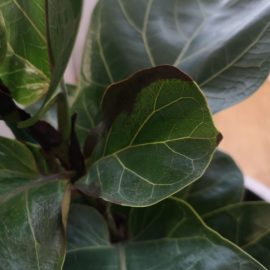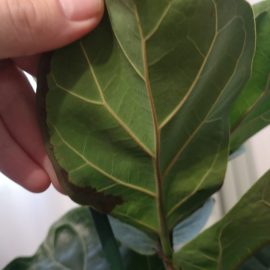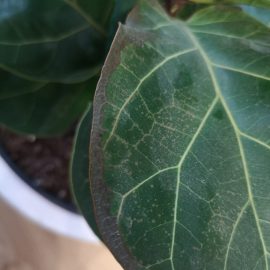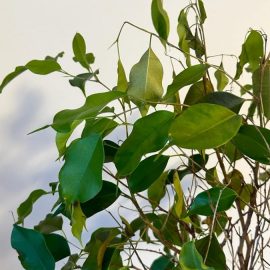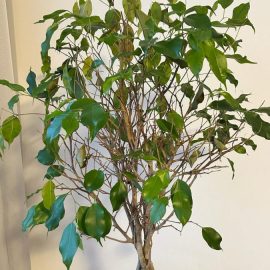Ficus, plant care and growing guide
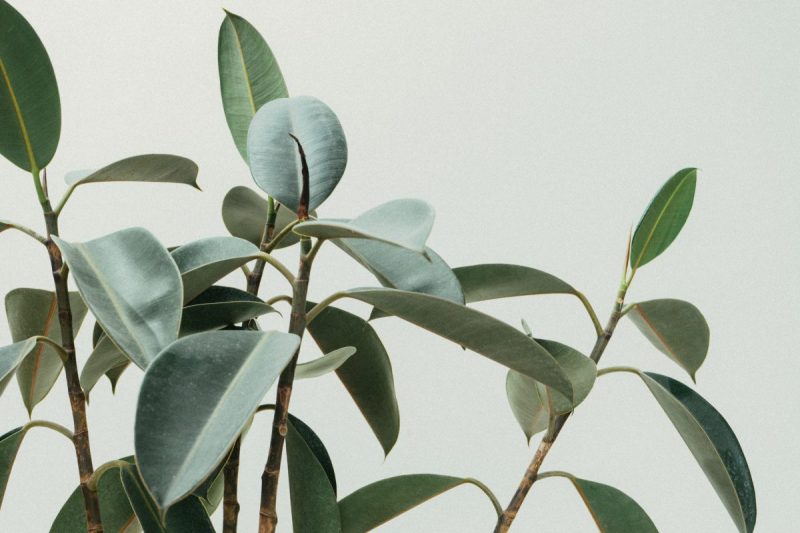
Originating from the tropics, the Ficus is a woody tree or climbing plant. It decorates the room with leaves that are special in shape, size, and color. The whole plant contains latex.
Here are the most famous species of Ficus grown as ornamental pot plants:
Ficus benjamina
Currently, it is one of the most cultivated species of Ficus. The plant is arborescent and it resembles a birch tree. It has fast growth, many branches, which are flexible and arched. The bark is light-colored. The leaves are numerous, persistent, 5-7 cm long, oval, with a sharp tip, intensely colored, bright green or green with shades of white or cream, depending on the variety.
Ficus elastica
It is one of the most widespread Ficus species. The plant has a columnar appearance, and in apartment conditions, it reaches 2-3 m in height. The leaves are 30-45 cm long, thick, glossy, simple, oval, protected by pink bracts. Height growth and branching are directed through pruning.
Ficus lyrata
It is one of the pretentious but also the prettiest Ficus. It has a columnar appearance and it has a slower growth. This plant has large bright green leaves, 30-45 cm long, obovate, with a wavy edge, leathery, and lighter-colored veins.
Ficus pumila
It is a creeping or hanging plant, with small leaves (2-2.5 cm), oval-rounded, intensely green. It has fast growth and can be directed through pruning.
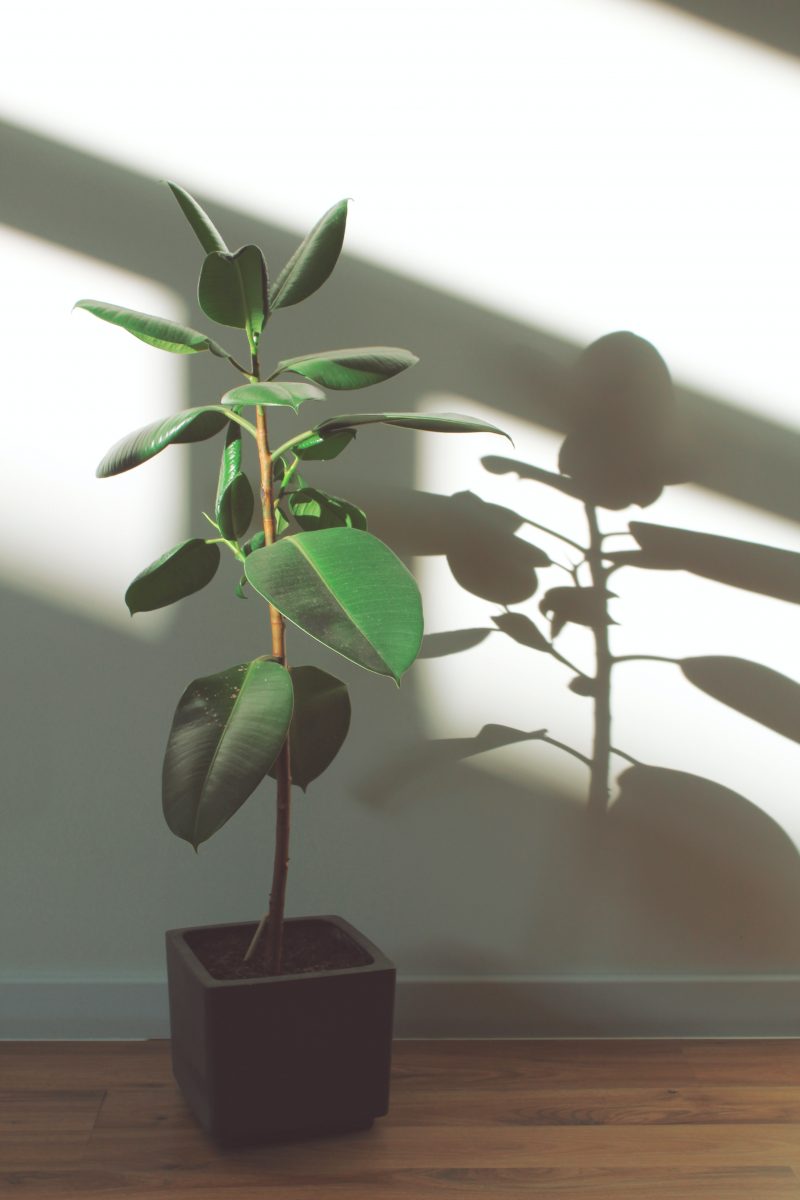
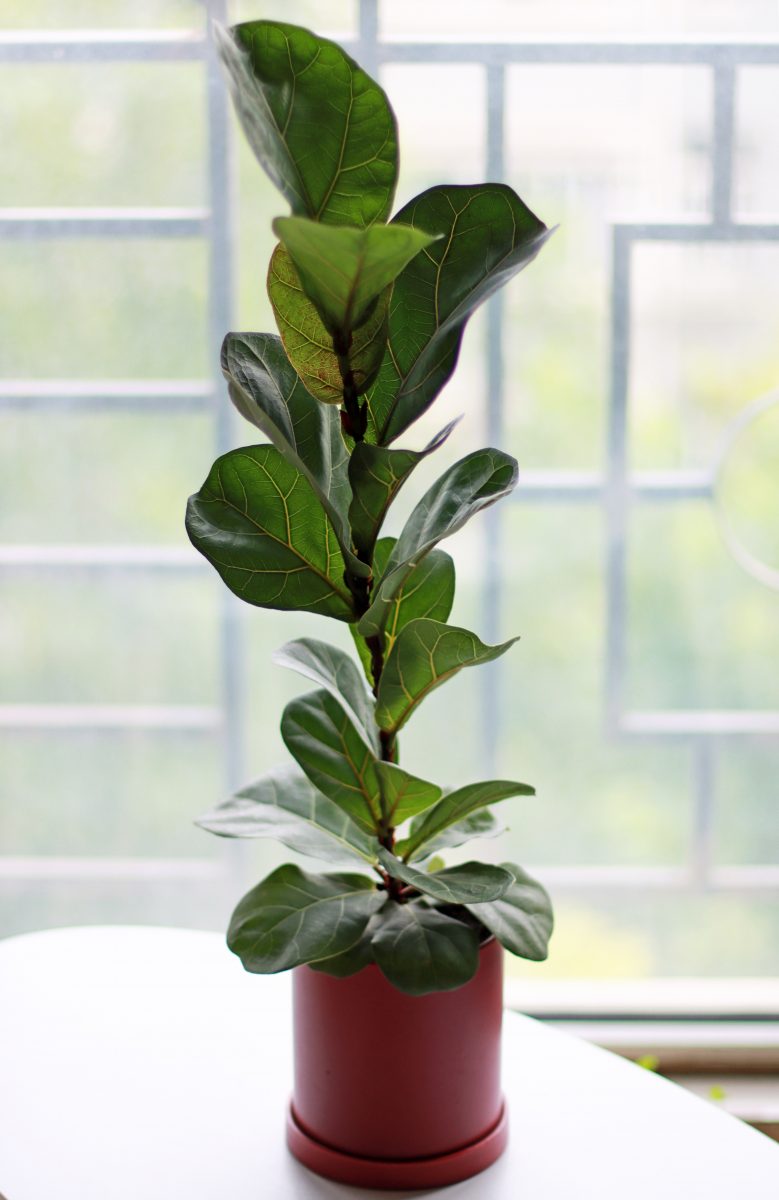
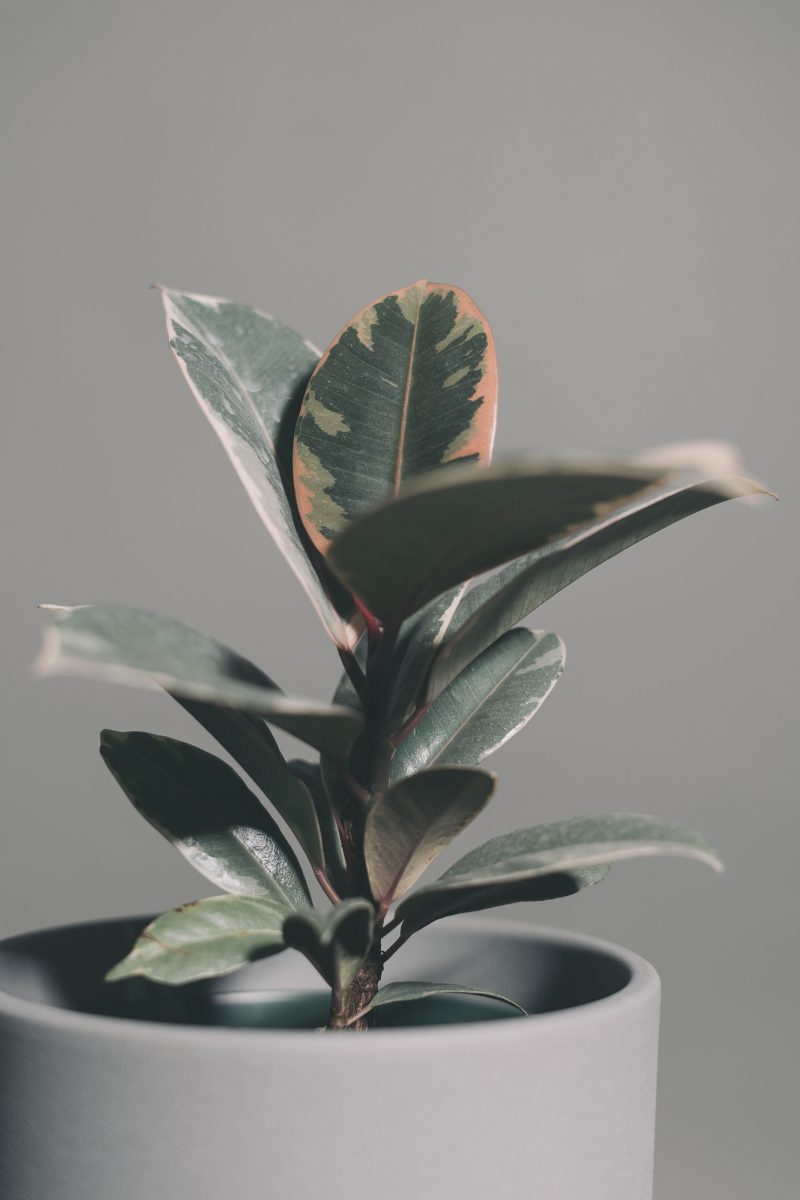

ENVIRONMENTAL CONDITIONS
Light. Light requirements differ depending on the species. Arboreal species (F. benjamina, F. elastica, F. lyrata) need more light. The plant should be kept in bright rooms in winter, and in summer it should be protected from the sun which is too strong during the day. Hanging species (F. pumila), on the other hand, prefer partially shaded places.
Temperature. The optimum temperature range is 18-20º C, and in winter it is necessary to ensure a minimum temperature of 12-13º C. Sudden temperature variations should be avoided, as they can cause leaf drop.
Humidity. Hanging plants (F. pumila) require high atmospheric humidity, and they need to be frequently sprayed with water. The other species also require spraying, especially in summer.
Substrate. It is recommended to use a substrate for houseplants, mixed with garden soil. At the base of the pot, a layer of gravel can be placed to facilitate drainage.
Recommended products
-
You can find products on a different store
Change Store -
You can find products on a different store
Change Store -
You can find products on a different store
Change Store -
You can find products on a different store
Change Store -
You can find products on a different store
Change Store -
You can find products on a different store
Change Store -
You can find products on a different store
Change Store -
You can find products on a different store
Change Store -
You can find products on a different store
Change Store -
You can find products on a different store
Change Store -
You can find products on a different store
Change Store -
You can find products on a different store
Change Store -
You can find products on a different store
Change Store -
You can find products on a different store
Change Store -
You can find products on a different store
Change Store -
You can find products on a different store
Change Store -
You can find products on a different store
Change Store -
You can find products on a different store
Change Store -
You can find products on a different store
Change Store -
You can find products on a different store
Change Store -
You can find products on a different store
Change Store -
You can find products on a different store
Change Store -
You can find products on a different store
Change Store -
You can find products on a different store
Change Store
Watering
It is done regularly with room temperature water, preferably in the morning. But before you water the plant again, it is recommended to let the substrate dry a little, since the excessive moisture can be more harmful to it than the lack of water. In winter, water less often.
Pruning
The procedure to correct the plant’s height and to stimulate branching should be done in spring, in March. During pruning, it is advisable to wear gloves, as most ficus species secrete an irritating sap.
Recommended products
-
You can find products on a different store
Change Store -
You can find products on a different store
Change Store -
You can find products on a different store
Change Store -
You can find products on a different store
Change Store -
You can find products on a different store
Change Store -
You can find products on a different store
Change Store -
You can find products on a different store
Change Store -
You can find products on a different store
Change Store -
You can find products on a different store
Change Store -
You can find products on a different store
Change Store -
You can find products on a different store
Change Store -
You can find products on a different store
Change Store -
You can find products on a different store
Change Store -
You can find products on a different store
Change Store -
You can find products on a different store
Change Store -
You can find products on a different store
Change Store -
You can find products on a different store
Change Store -
You can find products on a different store
Change Store -
You can find products on a different store
Change Store -
You can find products on a different store
Change Store -
You can find products on a different store
Change Store -
You can find products on a different store
Change Store -
You can find products on a different store
Change Store -
You can find products on a different store
Change Store
Fertilization
It can be done with foliar or granular fertilizers specially formulated for green plants’ nutritional requirements.
Recommended products
-
You can find products on a different store
Change Store -
You can find products on a different store
Change Store -
You can find products on a different store
Change Store -
You can find products on a different store
Change Store -
You can find products on a different store
Change Store -
You can find products on a different store
Change Store -
You can find products on a different store
Change Store -
You can find products on a different store
Change Store -
You can find products on a different store
Change Store -
You can find products on a different store
Change Store -
You can find products on a different store
Change Store -
You can find products on a different store
Change Store -
You can find products on a different store
Change Store -
You can find products on a different store
Change Store -
You can find products on a different store
Change Store -
You can find products on a different store
Change Store -
You can find products on a different store
Change Store -
You can find products on a different store
Change Store -
You can find products on a different store
Change Store -
You can find products on a different store
Change Store -
You can find products on a different store
Change Store -
You can find products on a different store
Change Store -
You can find products on a different store
Change Store -
You can find products on a different store
Change Store
Propagation
The Ficus can be easily propagated through top shoots, shoot fragments, or air layering, depending on the species. The optimal period for plant propagation is spring, between March and May.
Diseases and pests
The ficus can be attacked by woolly apple aphids and scale insects, but also by the red spider mite. Among the most common diseases are black spot, brown spot, anthracnose and Alternaria.
Recommended products
-
You can find products on a different store
Change Store -
You can find products on a different store
Change Store -
You can find products on a different store
Change Store -
You can find products on a different store
Change Store -
You can find products on a different store
Change Store -
You can find products on a different store
Change Store -
You can find products on a different store
Change Store -
You can find products on a different store
Change Store -
You can find products on a different store
Change Store -
You can find products on a different store
Change Store -
You can find products on a different store
Change Store -
You can find products on a different store
Change Store -
You can find products on a different store
Change Store -
You can find products on a different store
Change Store -
You can find products on a different store
Change Store -
You can find products on a different store
Change Store -
You can find products on a different store
Change Store -
You can find products on a different store
Change Store -
You can find products on a different store
Change Store -
You can find products on a different store
Change Store -
You can find products on a different store
Change Store -
You can find products on a different store
Change Store -
You can find products on a different store
Change Store -
You can find products on a different store
Change Store
Recommended products
-
You can find products on a different store
Change Store -
You can find products on a different store
Change Store -
You can find products on a different store
Change Store -
You can find products on a different store
Change Store -
You can find products on a different store
Change Store -
You can find products on a different store
Change Store -
You can find products on a different store
Change Store -
You can find products on a different store
Change Store -
You can find products on a different store
Change Store -
You can find products on a different store
Change Store -
You can find products on a different store
Change Store -
You can find products on a different store
Change Store -
You can find products on a different store
Change Store -
You can find products on a different store
Change Store -
You can find products on a different store
Change Store -
You can find products on a different store
Change Store -
You can find products on a different store
Change Store -
You can find products on a different store
Change Store -
You can find products on a different store
Change Store -
You can find products on a different store
Change Store -
You can find products on a different store
Change Store -
You can find products on a different store
Change Store -
You can find products on a different store
Change Store -
You can find products on a different store
Change Store
Additionally:
- blackening, drying and leaf fall are caused by high humidity in the substrate, large temperature fluctuations, drafts, low temperatures and insufficient light during winter.
- swellings and stripes are caused by excess nutrients, these symptoms being similar to those caused by the insect bites mentioned above.














































































































































































































































































































































































































































